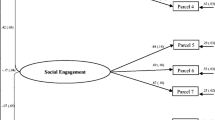Abstract
The Preschool Behavior Questionnaire is a teacher rating instrument yielding a total score reflecting overall level of adjustment and three subscale scores labeled Hostile/Aggressive, Anxious/Fearful, and Hyperactive/Distractible. This study assessed the convergent and discriminant validity of this teacher rating measure against two alternative measures within a multitrait-multimethod analysis. The results supported the construct validity of the Hostile/Aggressive and Anxious/Fearful scores as well as the overall score. There was, however, no support for the validity of the Hyperactive/Distractible score.
Similar content being viewed by others
References
Achenbach, T. M., & Edelbrock, C. S. (1978). The classification of child psychopathology: A review and analysis of empirical efforts.Psychological Bulletin, 85, 1275–1301.
Behar, L. B. (1977). The Preschool Behavior Questionnaire.Journal of Abnormal Child Psychology, 5, 265–275.
Behar L. B., & Stringfield, S. (1974). A behavior rating scale for the preschool child.Developmental Psychology, 10, 601–610.
Borko H., & Cadwell, J. (1982). Individual differences in teachers’ decision strategies: An investigation of classroom organization and management decisions.Journal of Educational Psychology, 74, 598–610.
Campbell, D. T., & Fiske, D. W. (1959). Convergent and discriminant validation by the multitrait-multimethod matrix.Psychological Bulletin, 56, 81–105.
Campbell, S., & Cluss, P. (1982). Peer relations of young children with behavior problems. In K. H. Rubin & H. S. Ross (Eds.),Peer relations and social skills in childhood (pp. 323–351). New York: Springer-Verlag.
Fowler, P. C., & Park, R. M. (1979). Factor structure of the Preschool Behavior Questionnaire in a normal population.Psychological Reports, 45, 599–606.
Gipps, C. (1982). Nursery nurses and nursery teachers I: Their assessment of children’s verbal-social behavior.Journal of Child Psychology and Psychiatry, 23, 237–254.
Hoge, R. D., & Butcher, R. (1984). An analysis of teacher judgments of pupil achievement levels.Journal of Educational Psychology, 76, 777–781.
Kohn, M. (1977).Social competence, symptoms and underachievement in childhood: A longitudinal perspective. New York: Wiley.
Lahey, B. B., Green, K. D., & Forehand, R. (1980). On the independence of ratings of hyperactivity, conduct problems, and attention deficits in children: A multiple regression analysis.Journal of Consulting and Clinical Psychology, 48, 566–574.
Quay, H. C. (1979). Classification. In H. C. Quay & J. S. Werry (Eds.),Psychopathological disorders of childhood (2nd ed., pp. 1–37). New York: Wiley.
Roper, R., & Hinde, R. A. (1979). A teacher’s questionnaire for individual differences in social behavior.Journal of Child Psychology and Psychiatry, 20, 287–298.
Rubin, K. H., & Clark, M. L. (1983). Preschool teachers’ ratings of behavioral problems: Observational, sociometric, and social-cognitive correlates.Journal of Abnormal Child Psychology, 11, 273–286.
Rutter, M. (1967). A children’s behavior questionnaire for completion by teachers: Preliminary findings.Journal of Child Psychology and Psychiatry, 8, 1–11.
Trites, R. L., & Laprade, K. (1983). Evidence for an independent syndrome of hyperactivity.Journal of Child Psychology and Psychiatry, 24, 573–586.
Venables, P. H., Fletcher, R. P., Dalais, J. C., Mitchell, D. A., Schulsinger, F., & Mednick, S. A. (1983). Factor structure of the Rutter “Children’s Behavior Questionnaire” in a primary school population in a developing country.Journal of Child Psychology and Psychiatry, 24, 213–222.
Author information
Authors and Affiliations
Additional information
This research was supported, in part, by a grant from the Pickering Foundation. The authors would like to thank Maria Bhaneja for her help in the collection and coding of data. Thanks are also extended to the teachers and children who participated in the study.
Rights and permissions
About this article
Cite this article
Hoge, R.D., Meginbir, L., Khan, Y. et al. A multitrait-multimethod analysis of the preschool behavior questionnaire. J Abnorm Child Psychol 13, 119–127 (1985). https://doi.org/10.1007/BF00918376
Revised:
Published:
Issue Date:
DOI: https://doi.org/10.1007/BF00918376



